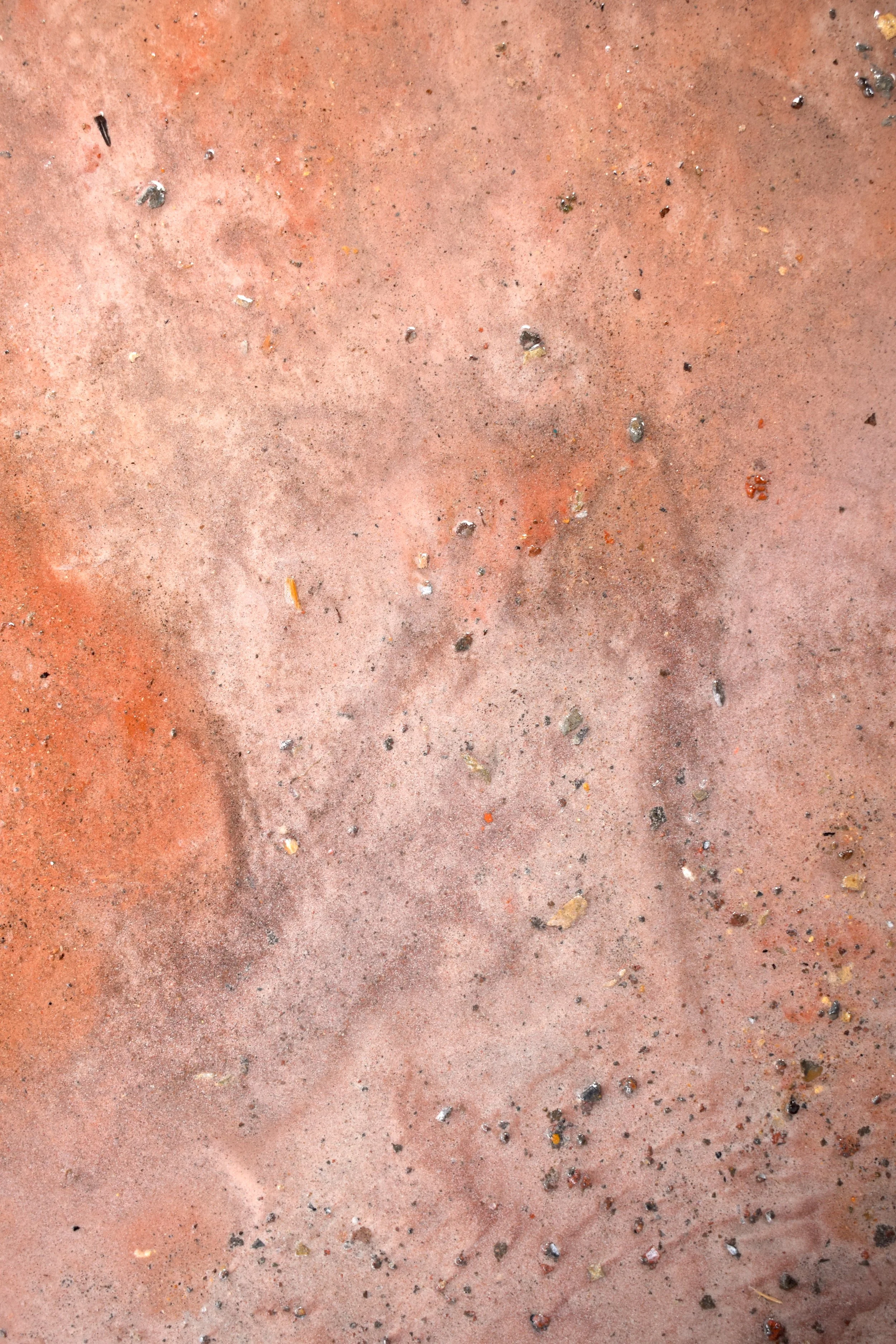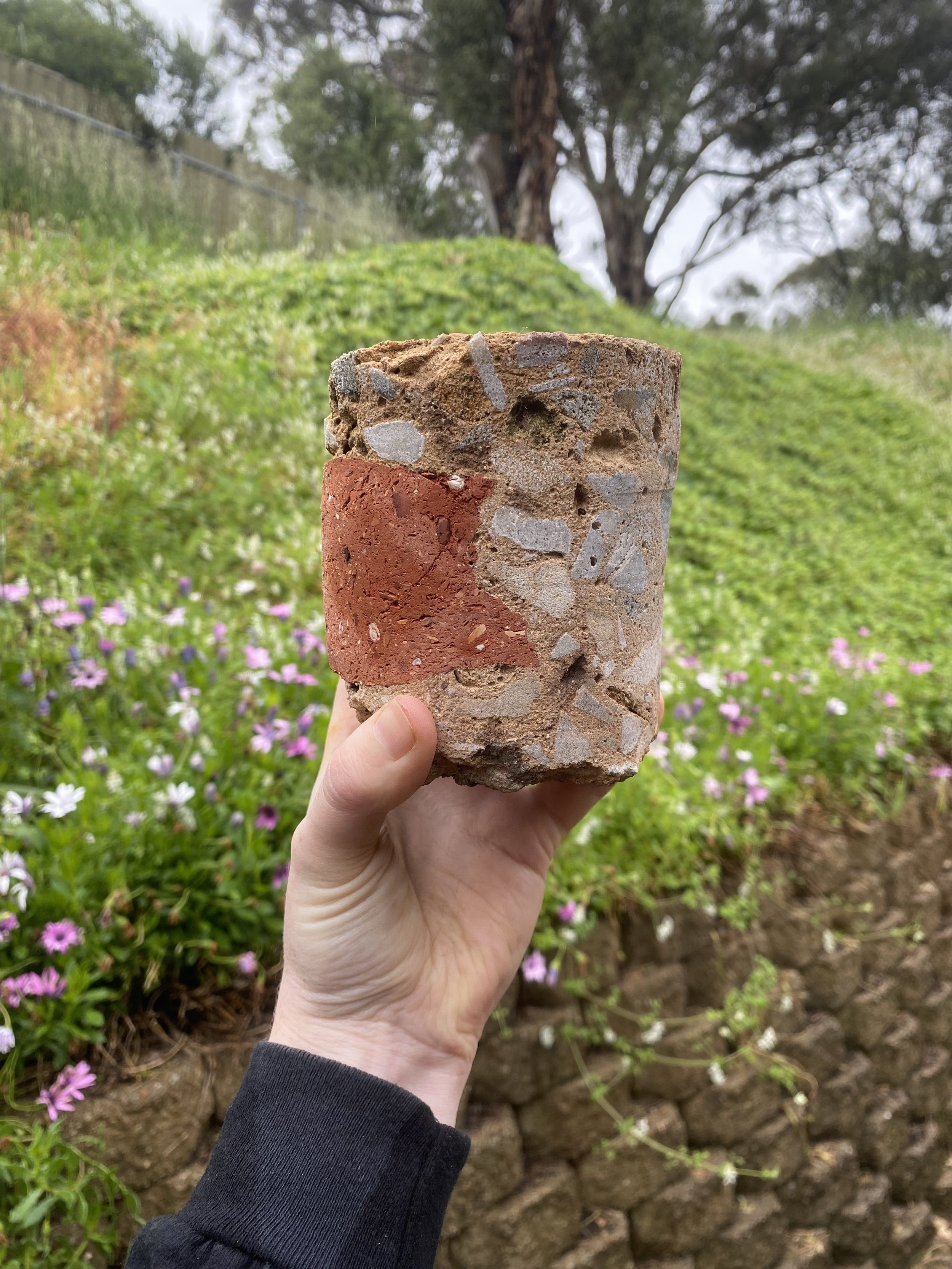
Recollecting ruins by Bernadette Klavins / Lightweight by Jacqueline Bradley and Rosalind Lemoh
Bernadette Klavins arrived at the meeting with a blunt object in her bag. She didn’t plan to use it. Or rather, she hadn’t decided yet how she planned to use it.
I could continue with Bernadette Klavins as a fictional character in an implied murder mystery but I don’t think it would aid the narrative of her work and process. Since the day of the blunt object encounter, I have written three completely different responses to the work that took me wildly off-track.
What was it about this conjugated suburban relic of the future that unsettled me?
In and of itself, it holds a grand modesty. Like a Greek column being conceived or germinated, confusing my sense of time.
The object that came out of the bag was a sample of something much bigger. An apocalyptic talisman or a cherished ruin?
The weight in my hand was unexpected. Its occupancy of mortar, brick, and ceramic amalgam was familiar. Traced with the recognisable fabric of streets walked, houses lived in, relationships had.
I laid it gently on the cushioned seat between pillows to stop it rolling or shattering from its own counterforce.
It had travelled to see me. Much like its compounded elements had journeyed from one place of rest to the next, each carrying a message in their movement.
There was something about its quality of getting here; the collecting from others through a virtual and physical marketplace, the gesture of adhesion, the predetermination of the core drill, that kept me oscillating between the local and the universal.
This stratified cylindrical form denied me a sense of order. Perhaps this is why I wrote all of a letter, a philosophical reflection, and a poem in reaction to it, that in the end, seemed to stray too far from the object itself to warrant a place here. And now this, a fictional tale based upon reality.
But I am clearer on this now. It is the object, not my writing, that is the wanderer.
Inneke Taal
Artist / Writer.

Bernadette Klavins, Studio document of an individual sample from Recollecting ruins taken after drilling, 2022.

Bernadette Klavins, Field process 1, 2022, digital print on paper, 84x116cm
Working with others to create art means exceeding, sharing and refiguring ways of working. It permits new expressions of the familiar and the strange, of identity and interaction. Rosalind Lemoh and Jacqueline Bradley are artists connected by a belief in the empowering creativity of shared ideas. Lightweight is a culmination of just some of their synergetic moments, arising from a decade-long conversation between the two.
Over those ten years, the artists have aligned in their investigations of how found man-made and natural materials signify specific social or ecological relations and can register in poetic, aesthetic ways. While Bradley draws connections between the natural and man-made, Lemoh riffs off the complexity of a body that holds multiple histories moving through space.
Despite their joint interests, Lemoh and Bradley have fine-tuned distinct aesthetic languages. Across Lightweight, the fragile ephemera of Bradley’s assemblages are tethered by the weight of Lemoh’s anodised aluminium and marbled concrete. Bradley creates unexpected pairings between everyday natural detritus (snail shells, feathers, seeds) and quotidian domestic objects (handkerchiefs, a comb, a sock). Lemoh, on the other hand, engages with the architecture of the same domestic spaces, disassembling marble and concrete and combining them with cast body parts (both human and non-human). For example, a wisdom tooth, crab claw and seed pod are all cast in white bronze in order to both defamiliarise and unify the matter.
Personal encounters with found objects impact the way each artist reformats them in-studio and on-site. Lemoh’s assemblages reflect an enduring preoccupation with memorial, still life and Arte Povera. As a Sierra Leone-born Australian artist, this means negotiating what it means to insert a black, female body into the Western Canon in a colonised Australia. The artist engages with this complex context with the light touch of elegantly-orbed forms combined with the heavy materiality of her sculptures. Bradley’s personal encounters with natural ephemera culminate in subtle interventions that contextualise their multilayered cultural meanings. The peach stones of Halves memorialise the annual offering from her own garden, contemplating associations of fertility, decay, and bodily metaphor, considering narratives beyond our lifetimes while encapsulating personal memories of watching the garden grow or peach juice dripping down the chin.
The exhibition title, Lightweight is a single compound word that distills two aesthetically opposing but conceptually overlapping practices. It belies the rigour of its authors and the duration of their dialogue, yet reflects the innate humour and poetic synthesis of their beguiling pairings.
Emma O’Neill

Rosalind Lemoh, In the night I draw the water, 2022, Anodised aluminium, white bronze, aluminium, 30x30x4cm. Photographed Damien Geary.

Jacqueline Bradley, Snail Hanky, 2021, handkerchief, cotton, snail shells, 20x20x2cm. Photographed by Brenton McGeachie.


